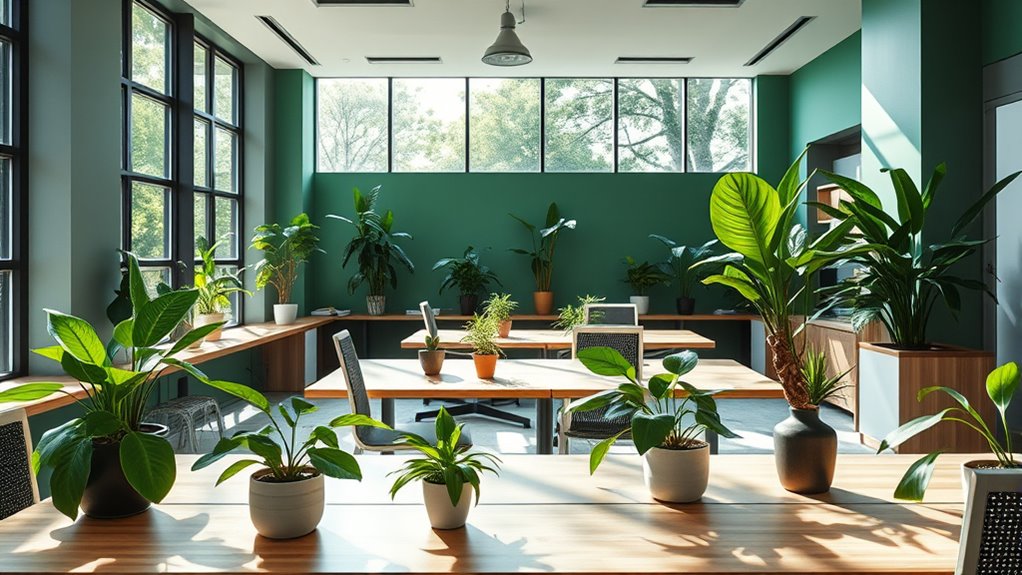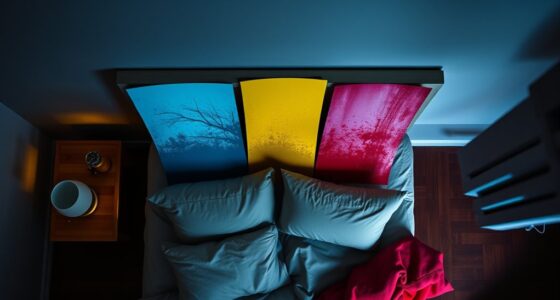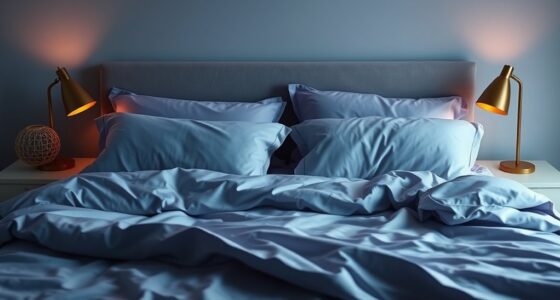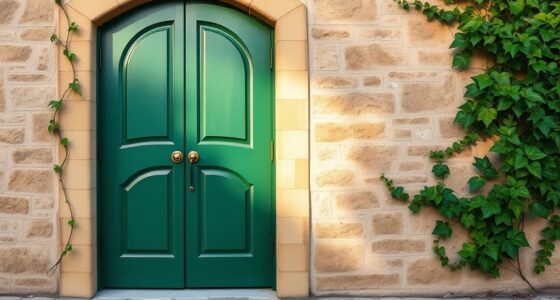Many offices are ditching dull gray walls for vibrant green to create inspiring, eco-friendly workspaces. Green hues and natural elements boost your focus, reduce stress, and enhance overall productivity. These design changes are based on research showing that natural environments foster calmness, creativity, and resilience. By incorporating more green, workplaces become healthier and more energizing. If you keep exploring, you’ll discover how this trend positively impacts your mental well-being and work performance.
Key Takeaways
- Green enhances concentration and reduces mental fatigue, improving overall productivity in the workplace.
- Incorporating natural elements like plants and green walls fosters a calming environment that boosts focus.
- Biophilic design principles connect employees with nature, leading to increased motivation and well-being.
- Green spaces in offices are linked to lower stress levels and better mental health, supporting sustained performance.
- Studies show that vibrant green environments inspire creativity and resilience, making workspaces more effective.
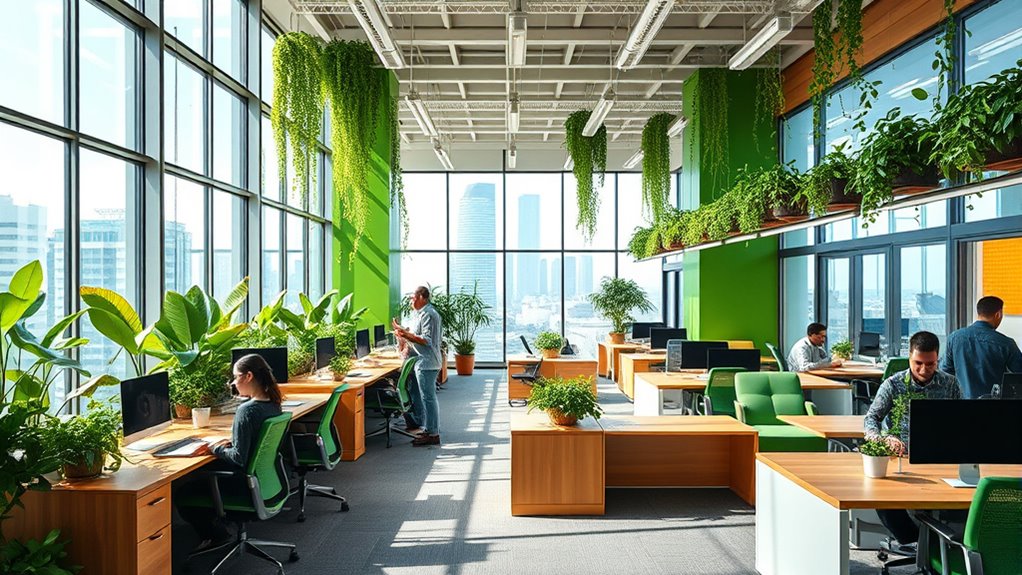
Many offices are moving away from dull gray tones and embracing vibrant shades of green to create more inspiring and eco-friendly work environments. This shift isn’t just about aesthetics; it’s rooted in principles like biophilic design and environmental psychology, both of which recognize the profound impact of natural elements on human well-being. When you incorporate green hues and natural elements into your workspace, you’re tapping into a deep-seated desire for connection with nature, which research shows can boost mood, reduce stress, and enhance focus.
Green office spaces boost mood, reduce stress, and enhance focus through natural design principles.
Biophilic design plays a vital role here. It emphasizes integrating natural patterns, textures, and colors into indoor spaces to foster a sense of harmony with the environment. When your office embraces biophilic elements—think green walls, plant-filled corners, or natural wood accents—it triggers positive responses in your brain. You might find yourself feeling calmer, more energized, and more creative. This approach aligns with environmental psychology, which studies how physical surroundings influence behavior and mental health. By choosing green tones and natural designs, your workspace becomes more than just a place to work; it becomes a space that nurtures your mental well-being.
Switching to green doesn’t just make your office look more lively; it actively enhances productivity. Studies reveal that exposure to natural elements and colors like green can improve concentration and cognitive function. When your environment feels more inviting and less sterile, you’re more likely to stay engaged with your tasks and less prone to fatigue. The calming influence of green reduces mental fatigue, helping you sustain focus longer and perform better. Additionally, incorporating plants and natural light, both staples of biophilic design, can lower stress levels, which further contributes to a more productive atmosphere.
You also benefit from the psychological effects of color. Green is associated with balance, renewal, and tranquility—qualities that foster a positive mindset at work. When you’re surrounded by shades of green, it’s easier to feel centered and motivated. This subconscious connection influences your overall attitude, making it easier to navigate challenges and stay resilient throughout the day. Moreover, awareness of the divorce statistics can remind us of the importance of creating healthy, supportive environments—whether at work or in personal life—that promote well-being and stability.
In short, the trend of ditching gray for green isn’t just about visual appeal; it’s a strategic move backed by science. By embracing biophilic design principles and leveraging environmental psychology, your workplace can become a more inspiring, healthier, and more productive environment. The next time you step into a green-infused office, you might notice yourself feeling more at ease, focused, and ready to tackle your tasks with renewed energy.
Frequently Asked Questions
How Does Green Color Influence Employees’ Creativity?
Green color boosts your creativity by leveraging color psychology, which shows that it promotes calmness and focus. When you’re surrounded by green, your mind feels more inspired and open to new ideas. Additionally, choosing green in office spaces can positively impact the environment by emphasizing sustainability. This environmental impact aligns with your well-being, making green a smart choice for fostering innovation and supporting eco-friendly practices.
Are Green Office Walls Cost-Effective to Implement?
Thinking about green office walls is like planting a seed for productivity. You’ll find that the cost comparison is quite favorable, especially considering the positive effects on mood and creativity. Installation costs are generally affordable, and many options are budget-friendly. While initial expenses vary, investing in green walls can boost employee well-being and may lead to long-term savings, making it a cost-effective choice for your workspace.
What Specific Productivity Metrics Improve With Green Decor?
Color psychology shows that green decor boosts focus, creativity, and stress reduction in your workspace. You’ll notice improvements in productivity metrics like task completion rates and employee engagement. Green enhances workspace aesthetics, making environments more inviting and calming. As a result, you’ll experience fewer errors, better problem-solving, and increased overall efficiency. Incorporating green decor directly supports a more productive, comfortable office environment, aligning visual appeal with measurable work performance benefits.
Can Green Colors Reduce Employee Stress Levels?
Imagine transforming your office decor and revealing a surprising secret—green’s calming power. Color psychology suggests that green can considerably reduce employee stress levels, creating a more relaxed environment. This subtle shift in decor influences mood and productivity, helping you and your team feel more at ease. Isn’t it fascinating how a simple color change can make such a difference? Green isn’t just vibrant; it’s a stress-reducing, productivity-boosting game-changer.
How Quickly Do Productivity Changes Occur After Color Updates?
Color psychology shows that productivity can improve within days after updating office design with new colors. When you introduce calming greens or energizing hues, you’ll notice employees feel more focused and less stressed, often within a week. The impact depends on how well the colors align with your workspace and team dynamics. So, if you change your office colors thoughtfully, you could see positive results fairly quickly.
Conclusion
As you walk into a green-painted office, it’s like stepping into a fresh forest that awakens your mind. Just like plants boost your mood and focus, switching from gray to green can transform your workday. With data showing productivity jumps, it’s clear that color isn’t just decor—it’s a catalyst for creativity. So next time you need a boost, remember: a splash of green might just be the secret your office’s productivity has been waiting for.
